Xi’an, China
December 11th and 12th, 2007
By Dan Murdoch
THE city of Xi’an exists in a cloud.
At least it did when I was there, a thick fog obscuring the sky and the tops of buildings. Smog or moisture or maybe both, our two days were spent walking in a damp, 100m wide bubble so it was impossible to grasp the scale of the place.
We passed a McDonalds and smart looking Starbucks to get to our hostel- the more time I spend in these Chinese cities, the less different they appear from their Western counterparts. It could have been one of those strange, misty London mornings where the city’s grey stone sits camouflaged and disorienting in the opaque. Only Chinese faces stared back at me, could still be home, but then, from the gloom, like a Polaroid developing, emerges a pagoda or temple unlike much outside Soho or the tower at Kew Gardens.
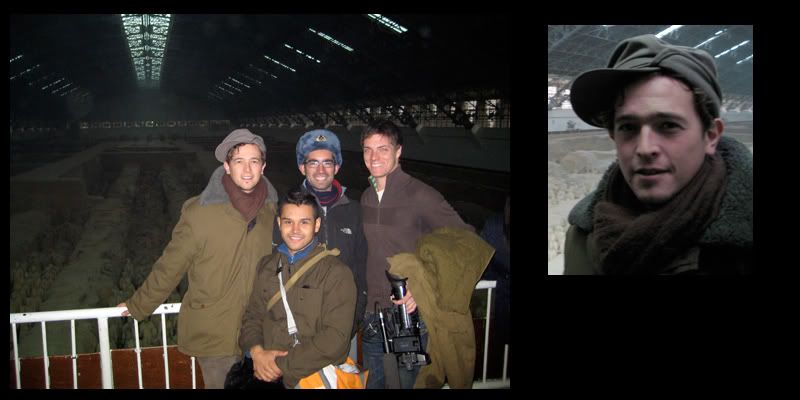
By the end of my week in Beijing I had grown too familiar, too comfortable in my little niche, to notice the city.
I woke up every day in the same place, in the same part of town. Began eating at the same joint, choosing my favourite thing off the menu, drinking the same beer and generally feeling comfortable. Familiarity didn’t breed contempt- I loved Beijing- but the excitement of the first few days dwindled into apathy, and the ink stopped flowing as the bizarre became the usual.
First impressions are best. When you don’t yet understand your surroundings and wander intrigued by the little differences. After five months of moving these changes are so quickly assimilated that Beijing’s early romance and novelty were too quickly taken for granted
So I was pleased to get out and try something new.
We grabbed the overnight train, Beijing to Xian, 12 hours. The air con went off in the night and for the first time in months I remembered what it is like to be too hot to sleep. The stiflingly close atmosphere on my top bunk (thee bunks high), freaking me out, and when we arrived I caught up on some sleep for an hour while OJ researched the city.
The Eighth Wonder of the World? According to some, the Terracotta Warriors here in Xi’an warrant a place with the Pyramids, the Oracle, and the rest on that controversial list.
We went to find out.
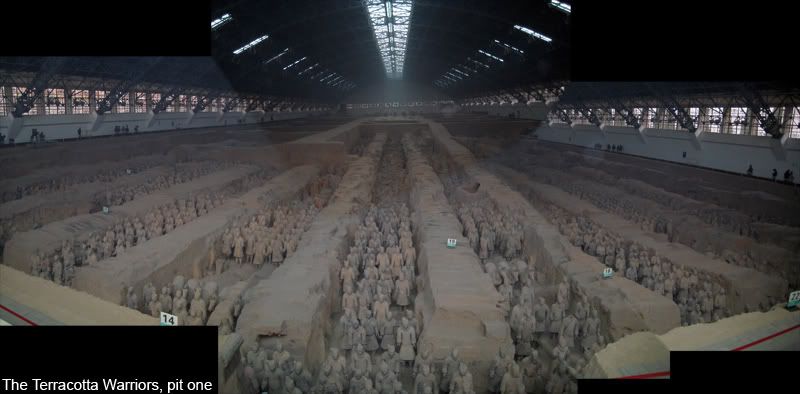
On another hot day in 1974, among bone-dry fields on the outskirts of Xi’an, and beneath the rolling stare of the legendary Lishan Mountain, a group of local farmers, suffering from the annual draught, began digging a well.
Hours into their work, and about ten feet down, Yang Xi Man struck something solid. Initially thinking it was a rock, he called for help, but when he and his friends dug further they found it wasn’t stone, but clay.
Clay that had been fired.
Working at the object more carefully now, in the darkness of the pit, the men slowly uncovered a round fragment, and dusting it off revealed the clay head of a warrior, staring back at them from a tangle of bamboo matting.
The men had unwittingly stumbled upon a chamber in the burial grounds of Emperor Qin Shi Huang, the infamous 3rd Century BC Chinese ruler. In fantasy style they had made one of the great finds of the 20th Century, uncovering a vault that had remained undisturbed and unknown for two millennia.

Emperor Qin has a mixed legacy. He is probably most famous for being the first man to unite the competing Chinese dynasties, quite a feat. He also began work on the first Great Wall, but possibly more importantly, he was responsible for standardising Chinese script, codifying his new nation’s code of laws, and regulating weights and measures for trading. All these changes, completed in the 15 years of his reign, served as the foundations for the next 2,000 years of Chinese development.
So far so good, but there were bad sides. He sparked the first Chinese peasant revolts by raising tax to 30%- the sheer cheek of it. Those peasants didn’t know how good they had it, 30%? We’d be singing in the streets with that kind of let off now.
He had a large mausoleum built which, according to legend has pearls imbedded in the ceiling to represents stars, and rivers of liquid mercury flowing around it, though no one has yet opened the 76m high mound. It is this grave that the Terracotta Warriors guard, standing about a mile to the west, and to ensure its secrecy Qin ordered the 700,000 labourers and artisans who worked on the tomb to be killed and buried with him.
At the time China had about 20 million souls, so roughly three or four per cent of them got the chop, and an even bigger percentage of skilled workers, were put to death.
Frightening.
He had a reputation for wanton cruelty, gouging out the eyes of courtiers who disagreed with him, summary executions, proclaiming himself a deity, questing for eternal life- typical emperor vices. What is it with these chaps? Everywhere we go we hear tales of the extreme cruelty of rulers. Maybe the kind ones get forgotten by history?
Oh yes and then there was Emperor Jin He Do, he liked chess and soft fabrics.
Doesn’t really work does it? History has no time for constants, it craves uproar and chaos so the story of mankind sounds like a constant affliction of despair: nasty brutish and short. Actually things were very nice during the 4th Century thank you very much, just not too much to write about.
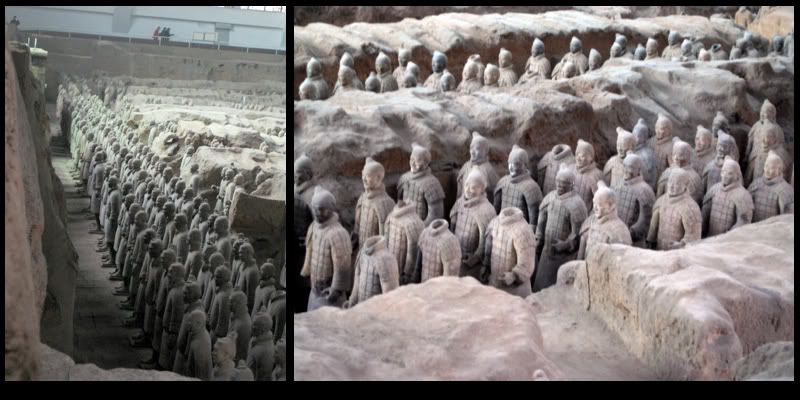
So back to the strange pit. Inside archaeologists found a huge, but mostly collapsed, subterranean cavern filled with an army of life-size warriors, finely detailed to the point of individually painted faces, all made of terracotta.
Not just a clever name.
There are spearmen, archers, swordsmen, skirmishers, cavalry and chariots, arranged in a battle formation ready to take on all comers- about 6,000 men in that pit alone.
The men form the army Emperor Qin took with him to the grave, guarding his nearby mausoleum and providing arms for him in the afterlife.
Thirty years after its discovery the pit is a major tourist attraction, covered in a grand marble and granite building, a modern reflection of the power of the state exercised beneath.
Strolling in, the scale of the pit took my breath away- the excavation is covered by a roof like an aircraft hanger- more than 200m long and over 70m wide. Underneath are 11 corridors, filled with warriors, standing four or five abreast, with the fronts and sides of the formation lined with men facing outwards to cover the rear and flanks.
The size is stupendous, and although only the front few dozen rows have so far been restored you can only guess at the completed picture when the last of the workers looked at the extent of their achievement before closing over the roof of the corridors with thick wooden beams, laying mats on the top then piling the ground with soil- the last men to glimpse the army in its full glory, more than two millennia ago.
Three more pits have been found since the first- there’s four in total, though pits three and four are only a fraction of the size of pits one and two.
Because we are generally turning out to be guided by a kind of supernatural luck and uncanny ability to be in the right place at all times, the best of these, pit two, was closed for refurbishment ahead of the Olympics next year.
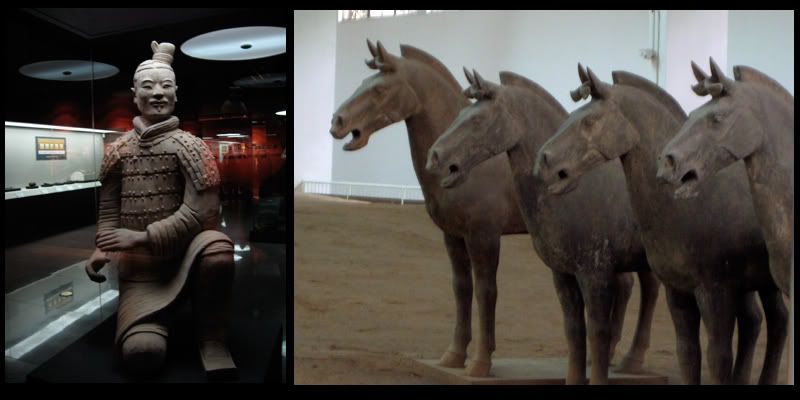
In the museum you can see the detail on the figures up close- it is pretty incredible, the curves of the chain mail armour, the folds of their robes, the detail of the faces and fingernails.
Back in the day each one was painted brightly. But after the unpopular Qin died his son and successor was assassinated. Mobs descended on the site of Qin’s tomb and managed to get into the vaults housing the terracotta army, which they burned then resealed.
So the archaeologists have to contend with fire damage along with the ravages of two millennia in collapsing subterranean cavities, but you can still see some of the paint on a few figures.
Every warrior was armed, the Chinese produced around 40,000 bronze weapons for the force- spears, halberds, swords, battle axes, hooks, bows, crossbows, arrows and the Chinese weapons the Pi, Shu and Ge. It is one of the world’s earliest surviving examples of mass production of weapons, and a showcase for early metallurgy.
When the archaeologists got at them, they found some of the weapons were still sharp.
In total, experts guess there are more than 10,000 warriors, but most are still buried under the gathered muck of 2,000 years. The archaeologists have spent thirty years digging them up and painstakingly piecing the breaks back together from millions of fragments, restoring the army to its formation. An epic, mind numbing work- and they want to complete the whole thing. Probably not in my lifetime.
In Pit 3, which is tiny in comparison to Pit 1, many of the blokes are headless, strange, eerie figures- like a London Dungeon diorama of the reign of James I. The ones with noggins seem to be smiling a little, but I guess I’d be laughing too if I’d spent 2,000 years watching my mates heads drop off. In a lot of places you can see the rubble that archaeologists have to deal with, a mass of jumbled hollow pieces, like a pile of leftover Easter eggs that have spent time in the sun.
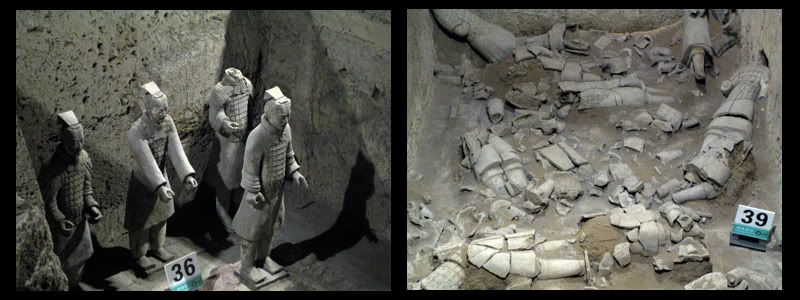
By closing time our visit descended into the usual farce of people being more keen to gawp and have their photos taken with us than the majestic sight before them. We smiled patiently.
Lucky the Trabbis weren’t here, it could have been a terrible distraction, and I wouldn’t want to invoke the ire of the proud clay warriors.
IF YOU READ AND ENJOYED THIS BLOG, WHY NOT SHOW YOUR APPRECIATION BY MAKING A SMALL DONATION?
www.firstgiving.com/trabanttrek
100% of your donation goes to Cambodian children’s charities.

Ends
For more of Dan’s blogs visit: http://danmurdoch.blogspot.com or www.trabanttrek.org

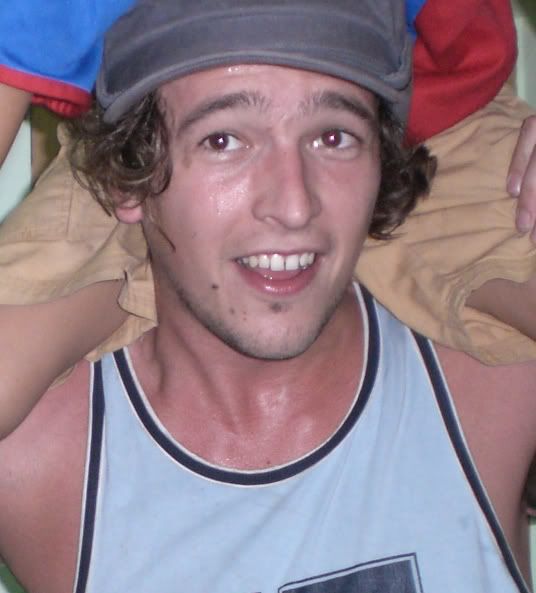
1 comment:
Great post, and photos to accompany them. Really liked the thought provoking side of this.
Where is next? Is it straight to the border or more of ancient China?
Post a Comment